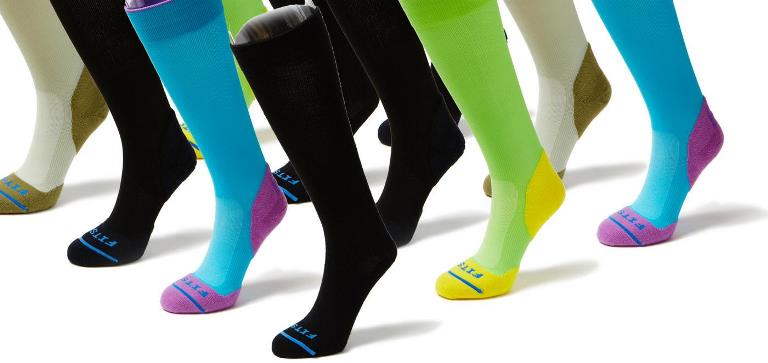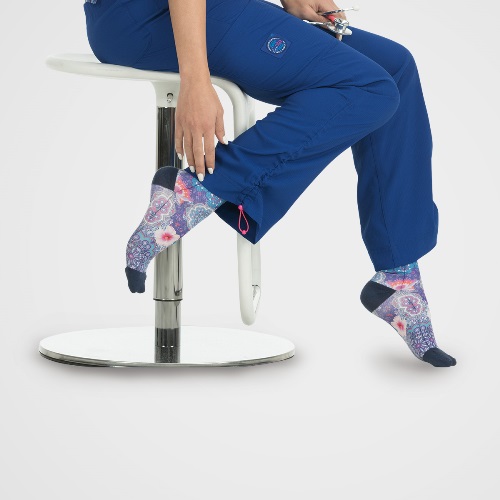Several questions and misconceptions abound every day concerning compression socks. Some of these questions arise from a lack of adequate knowledge about compression socks. Let’s start with you, what questions do you have about compression socks? Have you received an answer to it yet? Anyways, I will answer a few questions people often ask about wearing compression socks. People often ask how long they should wear compression stockings to help improve blood circulation. Another popularly asked question, “can you wear compression socks all day?” is our main topic of discussion today. Well, don’t let’s be quick to answer yes or no. Read this article further as I answer the question and other questions related to compression socks and when to wear compression stockings.
What are compression socks for?
Compression socks are designed specially to exert pressure on the lower legs which helps to maintain the flow of blood and reduce swelling and discomfort. Your doctor or health personnel may prescribe this if you have problems with adequate blood flow to and away from your legs.
These problems may lead to the following:
- Varicose veins: A condition that causes veins to appear enlarged and swollen.
- Lymphoedema; A condition where the tissues in the body swell up.
Wearing compression sock
Compression stockings are designed in various sizes range, colors, length, and compression strength. Before you wear compression socks, you will have your legs measured to ascertain whether it fits properly or not. Your doctor may recommend it for you to wear on one leg or both legs.
Ideally, compression socks should be worn during the day and taken off before retiring to bed at night. They should be worn again first thing the next day. You should have at least 2 socks, or 2 pairs if you are to wear them on both legs. This is a good idea as you can wear one while you wash and dry the other stocking or pair.
Your socks should be hand-washed at a comfortable temperature of 40C and dried without exposure to direct heat. Your progress will be monitored by your doctor while your legs will be measured at intervals of 3 to 6 month to assess whether your stockings should be replaced.
How to Choose and care for Compression socks

Compression socks are worn for several reasons. Some for comfort, other for sports, while it’s also medically recommended for various health conditions. They have the ability to improve the flow of blood, ameliorate pain and leg swellings. Also, they reduce the chance of contracting deep vein thrombosis (DVT), a serious blood clot issue, and other problems with blood circulation. Your doctor will decide on the best socks for you as they come in various strength and size.
What Are They?
As we have previously discussed, they are specially made tightly fitted and elastic which squeezes your leg gently. Graduated compression feels tighter around your ankles progressively become a bit loose as higher up your leg. Compression sleeves, on the other hand, simply tube part of the socks without the foot. You can purchase them at stores or if prescribed by the doctor, you may buy it through your insurance cover.
Who Uses Them?
Below is an extensive list of those who will need compression socks for various reasons and treatments.
- People with blood circulation problems such as varicose veins, DVT, or diabetes
- People who just had surgery
- Those having difficulty leaving the bed or moving their legs
- Athletes
- People whose work requires standing all day at work
- Pregnant women
- Those who travel a lot on an aeroplane such as pilots
What Do They Do?
Blood vessels are improved with the aid of pressure stockings. Arteries that carry oxygenated blood to your muscles relax thereby allowing blood to flow freely. The veins are enhanced by boosting blood flow and pushing it back to the heart.
Compression socks prevent leg ache, tiredness, and feet swelling. They also help to treat varicose and spider veins while they may also stop light-headed feeling or dizziness while standing. Due to the continuous flow of blood, there is little or no chance of blood accumulating or clotting in your veins.
What Kinds Are There?
Compression socks are designed in different lengths to cover various body parts. For DVT, most stockings are knee high, but thigh highs and tights are also available. Also, various compression and pressure levels are available and measured in mmHg.
Popular Articles on ComproGear
Best Compression Socks for Ankle Swelling What Are the Best Compression Socks for Swelling?
How to Wear Them

Smoothen the socks to let them stay flat against your skin. Watch out for bunching. Also, ensure they are not so long. Don’t roll down or fold the tops as it can be too tight which could lead to problems with blood flow and circulation. If it was recommended to you by your doctors, you’ll need to pay attention to instructions by wearing it most of the time. But when you need to shower, you can take them off. Socks, shoes, slippers, can all be worn over compression socks. Discuss with your doctor about the frequency of use.
If you have persistent issues with a blood clot and blood flow to your legs and feet, then you may be prescribed to wear compression socks. You may also need to wear these socks for a lengthy period, in some cases an entire lifetime.
compression stockings risks

Because compression socks designed to be tight, people often find it difficult to wear. Some of the common side effects of using compression socks include:
- Broken skin
- Skin irritation: Skin irritation could occur due to incorrectly worn compression stockings over an extended period.
- Discomfort
- Temporary marks on the skin
Wrong sized stockings, wrinkled and incorrectly worn socks could lead to problems. When there is an interruption in blood circulation such as peripheral neuropathy, nerves could be damaged especially in the legs which may result in the person’s inability to decipher whether the socks are too tight or loose.
Always, remove your stockings daily to observe your legs and feet for signs or extent of irritation or damage. You could use a mirror to check for that. If there are noticeable signs of new irritation, contact your doctor immediately.
Conclusion
Wearing compression socks may not get rid of varicose veins, but they may help to reduce swelling and pain associated with it. You can wear compression socks every day but you should remove it before going to bed and wear it first thing the next day.
